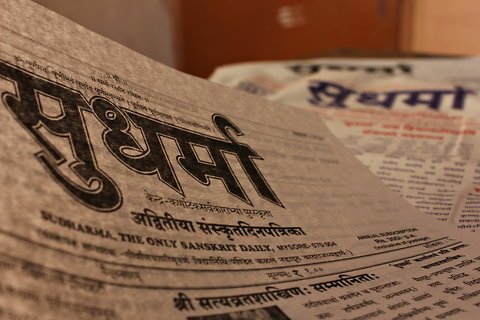
“Sudharma,” the world’s only Sanskrit language daily newspaper is published in Mysore, Karnataka. Photo: Raksha Kumar
In the sleepy old part of Mysore, there is frantic activity at dawn in one small alley, as Sampath and Jayalakshmi Kumar are busy at work. “This might not pay, but it is something I have devoted my life to,” said Sampath Kumar, editor of Sudharma, as he stands in front of an old typesetting machine that is used to publish newspapers.
Sudharma, which means “good faith” in Sanskrit, is world’s only Sanskrit-language daily newspaper that reports on the affairs of the world. Four pages in all, about 12 inches long, the paper covers a wide range of issues like India’s economic policy, politics, sports and weather. Sudharma’s circulation is a little under 2,000 copies per day, which go to Sanskrit scholars and students across India and abroad.
In 1970, when Mr. Kumar’s father, Varadaraja Iyengar, wanted to start the newspaper, he was met with resistance from various fronts. Not many people believed that Sanskrit, whose use declined in political and literary circuits in the 12th or the 13th century, had a vocabulary sufficient enough to cover the contemporary and complex activities and developments of each day. Mr. Iyengar took up this challenge by himself. “He just wanted to keep a ‘dead’ language alive,” Mr. Kumar said.
The question people were asking then was a natural one – why attempt to keep a dead language alive? “Sanskrit is an essential tool for anyone who wishes truly to understand India’s history over any longer period than the last two or three centuries,” said Professor J. L. Brockington, vice president of the International Association of Sanskrit Studies. “A proper understanding of its past is vital for any culture to truly stay alive — all the more so when, as is the case for India, that past stretches over so long a continuous period.”
Mr. Iyengar , who died in 1990, believed that the language was dying because it was not flexible enough to adapt to the changing times, said Nagaraja Rao, who has been the editorial head of Sudharma since its start. “And, therefore, we began simplifying Sanskrit,” he said. “We started adapting the language to express the ideas of modern India, what is happening in the elections, change of governments, the accidents on the road, et cetera. We had to invent new words to express new ideas like train, bus, police, democracy et cetera.”
Editing the paper takes Sampath Kumar more than five hours a day. He also translates news from other newspapers and tries to source articles from Sanskrit scholars from across the world.
Mr. Kumar’s wife, Jayalakshmi, who was also a student of Sanskrit language, is the only other permanent employee. “Enjoying what you do is more important,” she said, smiling. “The money will follow on its own.”
As for the money, the newspaper barely breaks even on most days, with revenue coming purely from subscribers — Indian subscribers pay 400 rupees ($7.20) a year, while overseas subscribers pay $50 – and donations, given largely by Sanskrit scholars. Sometimes the paper is solely funded by the Kumars, who produce the newspaper in the basement of their home. The office and the printing press together are smaller than a basketball court.
“The only reason we still continue to publish the paper despite all odds is because people tell us that they are extremely happy about the Language of Gods, or the Deva Bhasha, being brought to the people,” said Mr. Rao, “That we are making it Manava Bhasha – Language of the Common Man.”
Robert Goldman, a professor of Sanskrit at the University of California, Berkeley, said, “For the readers of Sudharma, having a daily journal of news and culture in Sanskrit is more a matter of pride and pleasure than of necessity. After all, no one actually needs to have his or her daily news reported in Sanskrit as there are many other sources of news in modern regional, national and international languages and, frankly, no one is truly monolingual in Sanskrit anymore.”
For now, Sudharma’s greatest challenge is to find more readers. “In our estimate, there are more than a 100,000 Sanskrit scholars in India and about a similar number abroad. But we have not been able to cross a few thousand in subscription,” laments Mr. Rao. The paper has begun a free online edition that can be accessed without a registration.
“Sanskrit as one of the great classical languages of India is comparable to Greek and Latin for Europe,” said Mr. Rao. “The genius of India saw its expression for more than 3,000 years in Sanskrit. And therefore, yesterday, today, and tomorrow, Sanskrit will remain important.”
Published in: The New York Times
Published on: 18 July, 2012
Link: https://india.blogs.nytimes.com/2012/07/18/in-mysore-keeping-sanskrit-alive-on-newsprint/

